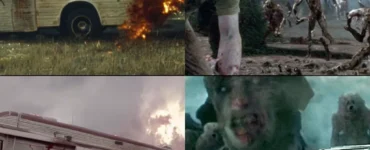What Happens When You Die? Everything you want to know
No living soul knows what really happens when we die, but here’s what we’ve gleaned from experience and a few near-death victims who claim they’ve glimpsed the other side.
In human history, both societies of the world have explored what happens when we die, both scientifically and spiritually — and the answer has always varied quite a bit.
What happens after you die is perhaps one of the greatest mysteries on Earth, mainly because none of us knows the answer, and yet all of us will eventually encounter death.
The great thinkers of mankind have been pondering this question for millennia. And in 1994, an orthopaedic surgeon named Tony Cicoria may have come close to solving this great mystery when he was struck by a near-fatal lightning bolt in upstate New York. Cicoria felt himself slipping backwards, and the last thing he recalled was turning around to see his body lying on the ground behind him.
He stood there for a while, Cicoria said, witnessing a woman perform CPR on her body before heading up a flight of stairs to watch his children play in their rooms.
“Then I was engulfed by a blue-white glow,” Cicoria said, “an incredible sense of well-being and calm… I flew at the highest and lowest points of my life. I had the feeling of speeding up, of being drawn up… and then, as I said to myself, ‘This is the most glorious feeling I’ve ever had,’ boom! I was out.
Cicoria ‘s encounter was not unusual, according to Dr Sam Parnia, who has been studying near-death experiences for years.
“Death is a procedure,” Parnia said. “It’s not a moment of black and white.”
In recent years, doctors like Parnia and close-up survivors like Cicoria have helped increase humanity’s understanding of what happens when we die.
What Science Says About What Happens When You Die
Though we can not completely grasp the sensation of dying until we witness it for ourselves, we know what happens to our bodies both before and after death.
At first, according to Dr Nina O’Connor, a person’s breathing becomes irregular and unusually shallow or deep. Their breath may begin to sound like rattling or a gurgle, which occurs because the person is unable to cough up or swallow secretions in his chest and throat.
“Much of this comes from the cycle of calming down and closing down the body,” she says. This tone was aptly called the “death rattle.”
Instead, at the moment of death, every muscle in the body is relaxed. This can lead a person to cough or sigh when any extra air is expelled from their lungs and into their throats and vocal cords.
In the meantime, as the body relaxes, the pupils dilate, the jaw may fall open, and the skin sags. If the person has any urine or faeces in their body, they will be released as well.
But as Parnia suggested, death doesn’t happen in an instant, and some researchers say that our brains can operate up to ten minutes after our hearts stop beating.
The body begins to experience “death chill” or “algor mortis” within the first hour of death. It is where the body cools off from its natural temperature to the temperature of the space surrounding it.
Within a few hours, blood starts to collect in parts of the body that are nearest to the ground due to gravity. It’s known as Livor mortis. If the body stays in the same position for a few hours, these parts of the body begin to look bruised, while the rest of the body becomes pale.
Limbs and joints may tend to stiffen within a few hours of death during a period called rigor mortis. When the body is at its full tension, the knees and elbows may be flexed and the fingertips and toes may be crooked.
But after about 12 hours, the rigor mortis cycle will continue to reverse. This is due to internal tissue deterioration which lasts between one and three days.
During this transformation, the skin starts to contract and shrink, causing the impression that the person’s hair, nails, and teeth have grown.
This tightening of the skin is also responsible for the illusion that blood was sucked from the corpses, which in turn inspired some of the vampire legends of medieval Europe that we still know today.
What Physicians Say It Feels Like When We Die
Death, according to some doctors, can feel either a great depression or a need for pooping.
Apart from the science of death and decomposition, people have always wanted to learn what the experience of dying is like. Since most of us, unlike Cicoria, will never have a near-death experience, we are honestly left wondering: what does it feel like to die?
And according to Dr Clare Gerada, a general practitioner, death will also feel like needing to use the toilet.
“Many people will die in bed, but the rest of those who do not will die sitting on the lavatories. That is because there are certain fatal incidents, such as a massive heart attack or a lung clot, where the body feels like you want to defecate.
If a person does not die from a terminal event, however, and rather moves more slowly from a long-term illness or old age, dying may feel a bit of depression. Towards the end of their lives, people prefer to eat and drink less, resulting in exhaustion and loss of strength. This causes them to move, to talk, and to think slower.
Dr O’Connor notes that “physical exhaustion and weakening [of people at the end] is profound. Simple stuff, like getting out of bed and into a chair, could be exhausting — that could be someone’s strength for a day.
But since dying people ‘s description of how they feel during the process is too often complicated or elusive, the issue of how it feels when we die remains widely enveloped in mystery.
What Happens To Your Body After You Die, Practically Speaking
While the most ineffable aspects about what it is like to die will still be elusive, what is very obvious is what happens to the body after death in a realistic sense. Yet how we treat our dead bodies and how we conduct rituals and rites vary widely across the world.
In the West, bodies usually get embalmed after death. The embalming cycle dates back to the ancient Egyptians — and perhaps earlier — when some civilizations mummified their dead in the expectation that their spirit could one day return to the body. Similarly, Aztecs and Mayans had a tradition of mummifying their dead, as did many of the most researched cultures of the pre-modern period worldwide.
Yet as with new, Western procedures, embalming in the U.S. first became common after the Civil War as a way of moving wounded veterans back to bury their relatives.
Traditional embalming is a tedious operation. When a doctor has confirmed a person is deceased, the body is delivered to a coroner who can call for a postmortem exam. This method involves an external and internal review by a pathologist. The pathologist removes every organ of the body, from the tongue to the brain, for internal examination, and then inspects it and puts it back in the body.
The body is then drained of all its fluids which are replaced with a preservative such as formaldehyde. Meanwhile, cotton wool is stuffed onto the mouth and nose. The lining of the mouth is stitched or locked using glue. It washes the scalp, cleanses and removes the nails, and applies makeup to the face and hands. Beneath the eyelids, plastic caps are applied to help keep their shape.
The body is eventually wrapped and put in a coffin. Based on the person ‘s choice, history, or religion it may be buried or cremated from here.
Death ceremonies are also very different in many non-Western cultures from what most of us would learn.
This is especially true of Indonesian Toraja people. They believe the dead never really go away, so people aren’t so quick to dispose of the bodies of their loved ones.
When a Toraja person dies, their family takes care of their body until they can prepare a proper funeral — which can take weeks to months or even years.
During this time, the deceased is treated as though they are just sick rather than dead. If the funeral is finally finished, the village of Toraja honours the deceased with prayers, music, and animal sacrifices before carrying the body to its grave.
The body, though, is not forever left in its crypt. The Toraja people exhume their loved ones every one or three years, scrub them clean, dress them in new clothing (and sunglasses), and walk them around so they can do stuff like introducing them to some potential family member.
On the other hand, Jews don’t embalm their loved ones and instead quickly bury them after they’re declared dead. Rabbi Corey Helfand says, “We give our bodies back to the Earth and to God [according to] the scriptures we read in Genesis, of Adam coming from the Earth— that’s why we bury our dead”.
Therefore, Jews are usually buried naked, wrapped in a sheet of cotton and laid in a simple pine coffin so that the body can naturally decompose. Muslims do the same with their dead; in some cases, they bury them without a coffin.
At the other hand, medieval Christians lived their lives anticipating and planning for death, mainly because they had been engulfed by it. There were high rates of infant mortality and malnutrition without conventional medicine, while starvation and war were rampant, too. That, after all, was the age of Black Death. Therefore, Christian Europeans (and Americans) often prefer towards ceremonies of burial, which are more heavily planned and organized in terms of items such as coffins and funerary rites.
The ancient Egyptians, however, claimed the deceased needed to travel into the underworld first before they could rest in the afterlife. But the journey to the afterlife was full of challenges, so the ancient Egyptians buried their loved ones with spell-inscribed scrolls to shield them and lead them to their final place of rest. Archaeologists have discovered maps of the underworld in graves that were supposed to lead the deceased in the afterlife.
What Really Happens After You Die — From People Who’ve Been There
Leaving aside what happens to the body of the dead when they die, what happens to them and their entire life and soul? Although the traditions and beliefs of the world may give any potential solutions, witnesses with near-death encounters may be able to do so.
Actress Jane Seymour went into anaphylactic shock in 1988. The mind remained conscious while the body started to slow down.
“I had the dream of seeing a bright light and looking down and finding myself in a bedroom with a nurse frenziedly trying to save my life and jabbing needles into me, and I’m quietly watching an entire thing,” she said, explaining a scenario familiar to those who have nearly died in stories.
During his 2014 study of near-death encounters, Dr Sam Parnia documented this occurrence with multiple survivors. One patient could remember what was going on in the hospital for three full minutes after his heart had stopped.
“The man mentioned all that had happened in the house, but he heard two bleeps from a computer at three-minute intervals which create noise,” Parnia said. “And we should have had time for how long the experience lasted. He appeared quite honest and everything that he had said had really happened to him.
While not every survivor of whom Parnia talked has an out-of-body experience, as many as 40% of them did remember experiencing any form of “awareness” after they were officially declared dead.
Particularly after flatlining, many patients remember seeing a warm, friendly sun, or their dead family, or the doctors and nurses in the ambulance working with them.
Moreover, many of the people who experienced consciousness after death remember that they did not want to return to their bodies.
Yet other scientists remain suspicious of these findings, attributing them to anything from vivid dreaming to a loss of brain oxygen. While there is a need to do more work before we know for sure what happens as we die, maybe it is at least reassuring to believe that our soul is moving on when our bodies expire.






